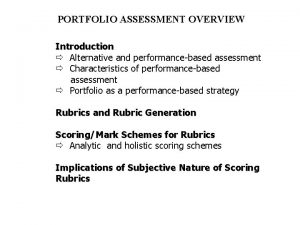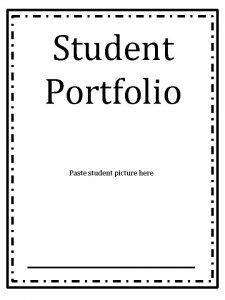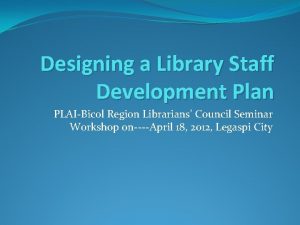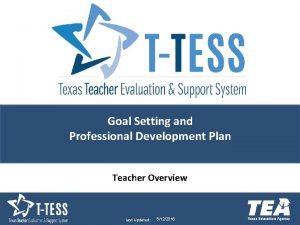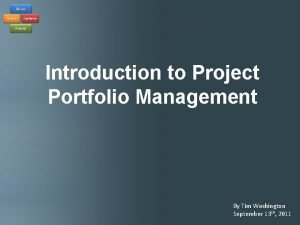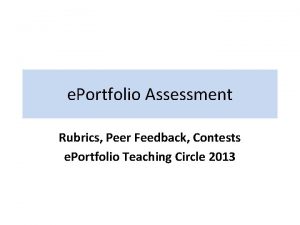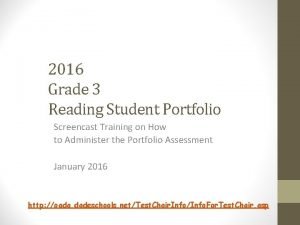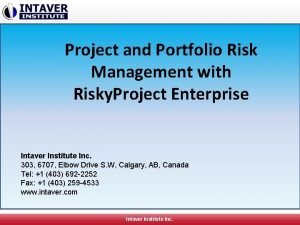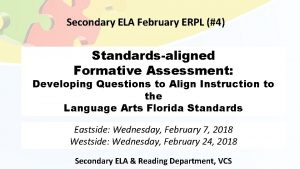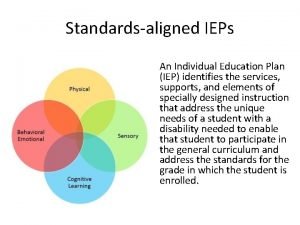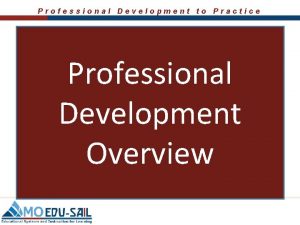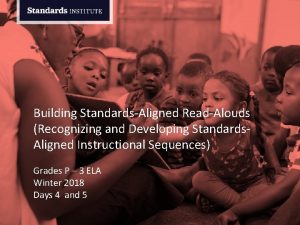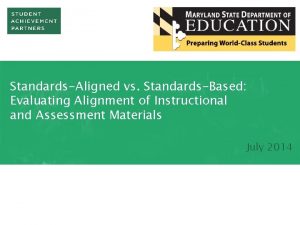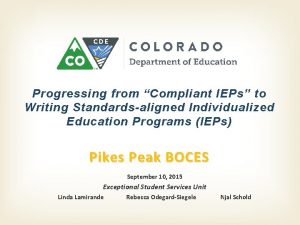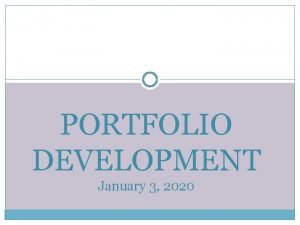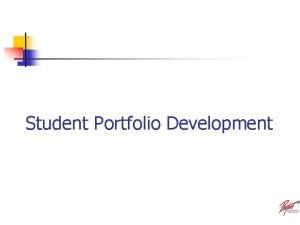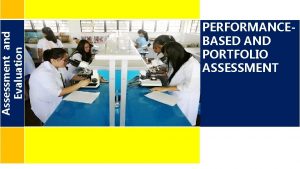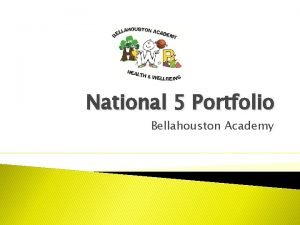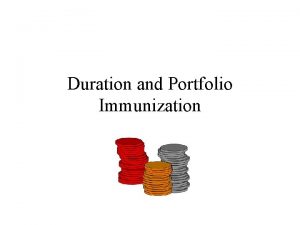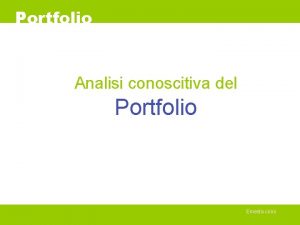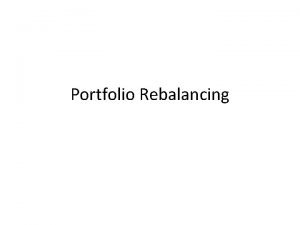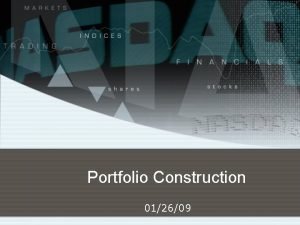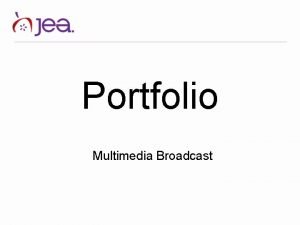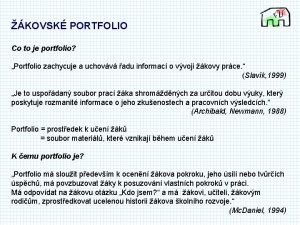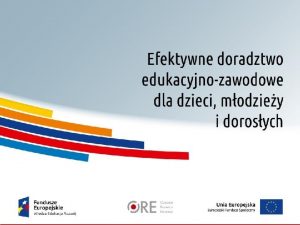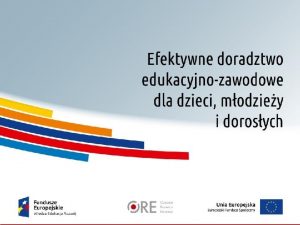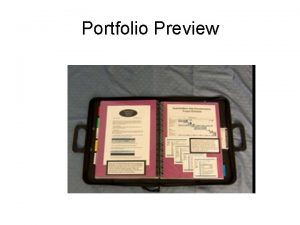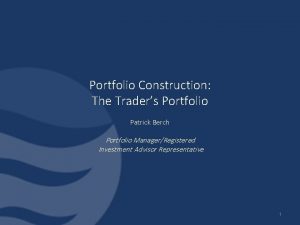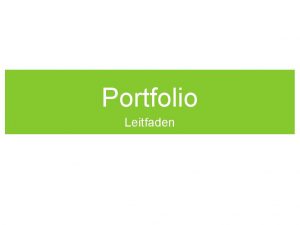StandardsAligned Portfolio Assessment A Professional Development Plan for




























- Slides: 28

Standards-Aligned Portfolio Assessment A Professional Development Plan for Hilliard Bradley High School

Hilliard Bradley High School

What is a Portfolio? A systematic collection of student work and related material that depicts a student's activities, accomplishments, and achievements in one or more school subjects. The collection should include evidence of student reflection and self-evaluation, guidelines for selecting the portfolio contents, and criteria for judging the quality of the work. The goal is to help students assemble portfolios that illustrate their talents, represent their writing capabilities, and tell their stories of school achievement. (Venn, 2000, pp. 530 -531)

Two Types of Portfolios: Process portfolio documents the stages of learning and provides a progressive record of student growth. Teachers use process portfolios to help students identify learning goals, document progress over time, and demonstrate learning mastery. Product portfolio demonstrates mastery of a learning task or a set of learning objectives and contains only the best work.

Tests or Portfolios? “Performance assessments fill the void that is left by standardized tests; they provide a more complete picture of Performance the whole learner. ” Traditional Assessment • Perceived as objective • Can measure the important • Provide ease of grading and consequently more data • Provide only a snapshots of a student’s ability. ” • No single instrument can measure all that students know about a concept or issue. • Not every student will be up to giving their best performance on any specific occasion. Phelps element of growth over time which cannot be assessed with a single measurement. • Authentic assessment of the range of a students’ knowledge and skills. • Student Centered due to a process which includes the student in goal writing, reflecting and evaluating.

Advantages of Portfolio Assessment Promoting student self-evaluation, reflection, and critical thinking. Measuring performance based on genuine samples of student work. Providing flexibility in measuring how students accomplish their learning goals. Enabling teachers and students to share the responsibility for setting learning goals and for evaluating progress toward meeting those goals. Giving students the opportunity to have extensive input into the learning process. Facilitating cooperative learning activities, including peer evaluation and tutoring, cooperative learning groups, and peer conferencing. Providing a process for structuring learning in stages. Providing opportunities for students and teachers to discuss learning goals and the progress toward those goals in structured and unstructured conferences. Enabling measurement of multiple dimensions of student progress by

Disadvantages of Portfolio Assessment Requiring extra time to plan an assessment system and conduct the assessment. Gathering all of the necessary data and work samples can make portfolios bulky and difficult to manage. Developing a systematic and deliberate management system is difficult, but this step is necessary in order to make portfolios more than a random collection of student work. Scoring portfolios involves the extensive use of subjective evaluation procedures such as rating scales and professional judgment, and this limits reliability. Scheduling individual portfolio conferences is difficulty and the length of each conference may interfere with other instructional activities. (Venn, 2000, p. 538)

1990 -93 Vermont Assessment Program Two Goals 1) To provide high quality data 2) To induce improvement of instruction. There was a clear tension between these two goals. Conclusion: A compromise needs to be made between improved quality of data and improved instruction to students. For this type of large scale performance assessment, “there is a need for modest expectations, patience, and on-going evaluation. ”

In Vermont … Writing and Math grade 4 and 8 Bottom up approach, no constraints, student centered Portfolios done alongside standardized assessments (example: essay prompts all on the same topic) Not graded by classroom teacher, graded during regional meetings

Vermont Findings • Mathematics teachers reported devoting more time to problem solving and communication. -1/2 report more time spent in exploration of math problems -3/4 report more time spent more applying math to new situations -70% report more time spent making charts, graphs, and diagrams -70% report more time spent writing reports about mathematics • Program caused even recalcitrant teachers to change their instruction. • Teachers and principals of the Vermont program generally characterized it as a “worthwhile burden. ”

A 1990 study by the Center for Research on Evaluation, Standards, and Student Testing at the University of California – Los Angeles concluded that “Nearly half of state testing programs either had performance assessments in place, were planning to implement them, or were actively exploring the idea. ”

“I think that the best thing to do is have the students show you what they know. Now, it’s harder to grade, but it gives you a much better idea of what the person actually knows. Instead of saying to students, ‘Here’s a question, do you know it? ’ Now I’m saying ‘Tell me what you know about this topic. ’” -Chemistry Teacher (Journal of Chemical Education, 1997)

“I think (the portfolio) is a good way to show what we have learned but it is a lot of work to try to get everything right. I’d rather do a portfolio than take a major test, because if I’m not feeling well the day of a major test I probably won’t do well. The portfolio is a project that doesn’t grade you on one day but your work over a long period of time. ” -Student Response

Portfolio Assessment at Bradley Improving student learning by improving assessment

Overview Departments will decide on framework for department (how many and what types of portfolio entries will be graded) Grade level/data teams will decide on specifics of portfolio entries, align standards, create descriptions and rubrics Portfolios graded at semester and end of year Portfolios to be a combination of teacher-assigned and student choice Portfolios will be collectively graded by department to increase reliability

Portfolio Planning Chart

Timeline for Planning May 9 - Department Meeting: Begin discussing what types and numbers of portfolio entries (4 -6 entries) are appropriate for department May 16 - Department Meeting: Make final decisions about numbers, types and descriptions/titles for entries (examples: interview, lab report, research paper, timed writing, resume, student choice) May 23 - Data Team Meeting: Fill in Portfolio Planning Chart by grade level, Align Standards May 25 - Department Meeting: Share-out what grade levels entries will be, share/collaborate on descriptions and rubrics. Aug 22 - Data Team Meeting: Finalize portfolio descriptions and rubrics

Resume and Interview Portfolio Assignment Description


Portfolio Related PD for 20132014 Speaker from Vermont Department of Education Speaker on Portfolio/Performance Assessment “Lunch and Learns” will focus on using performance assessment more effectively Time during data team meetings for portfolio planning and grading Early release time to be scheduled before and during exam week each semester for collective, departmental grading of portfolios

Portfolio Assessment in Other Contexts From preschool to grad school, portfolio assessment provides a more clear picture of the learning that is taking place

Information to Include in Speech and Language Portfolios Referral form Language Samples Story Retell Samples Observation Notes Work Samples Teacher Interviews Parent Interview Linder, Toni W. (1993), Transdiciplinary Play-Based Assessment: A Functional Approach to Working with Young Children (Revised Edition). Baltimore: Paul H. Brookes Publishing Co.

SUGGESTED ITEMS TO CONSIDER FOR MATHEMATICS PORTFOLIOS Open-ended questions. A report of group project. Work from another subject area. Problems posed by student. Art projects. A book review. Excerpts from a student's daily journal. A table of contents. Draft, revised, and final versions of student work on a complex mathematical problem. A description by the teacher of a student activity that displayed understanding of a mathematical concept.

MORE SUGGESTED MATH ITEMS A letter from the student to the reader of the portfolio, explaining each item. Audio tapes of student-teacher interview. A photo or sketch made by student of student's work with manipulatives. Papers that show the student's correction of errors or misconceptions. Notes from an interview by the teacher or another student. Sample journal entries. Work in the student's primary language. Videotapes of student's work. A mathematical autobiography. Mathematical research.

EXAMPLE: Fitness Portfolio Purpose: to demonstrate your ability to assess and evaluate your fitness level, set appropriate personal fitness goals, and design a personal fitness program to meet those goals over the course of the semester. What is to be included: 1. An assessment of personal fitness in all 5 HRPF dimensions and identification of which methods you used to assess that aspect of fitness. 2. A presentation of your judgment about the meaning of the fitness scores 3. A presentation of your goals based on the data you have collected 4. Evidence of what you have done to meet those goals and your level of success with those goals. Assessment of the Portfolio: 1. Includes evidence supporting the above 4 dimensions 2. The evidence supplied is accurate 3. The evidence is adequate to support your ideas 4. The evidence supplied communicates clearly https: //peandhealtharkansas. wikispaces. com/. . . /PED+393+Authentic+. . .

Teacher Preparation Portfolio Teacher background. Class description: time, grade and content. Written examinations: National Teacher's Exam, State licensure tests. A personal statement of teaching philosophy and goals. Documentation of effort to improve one's teaching: seminars, programs, etc. Implemented lesson plans, handouts and notes. Graded student work such as tests, quizzes and class projects. Video/audio tape of classroom lessons. Colleague observation records. Written reflections on teaching. Photographs of bulletin boards, chalkboards or projects.

In Conclusion Portfolio Assessment has been shown to improve both teaching and learning. It is shown to be a better assessment tool than traditional exams. To the teachers of Bradley, we are here to support you in every way possible. Thank you for making portfolio assessment an integral part of your curriculum design and bringing our kids center-stage in the process. They deserve it.

Works Cited Trovato, Marlene C. , B. S. An Investigation of Portfolio Assessment Implementation within the Limits and Constraints of a Traditional Classroom Setting. Thesis. Otterbein University, 1983. n. d. Print. Friedlander, Steven. "Lessons of Secondary School Experience Using Math Portfolios in an Algebra Classroom. " Portfolio Assessment A Handbook for Educators. Ed. James Barton. N. p. : Dale Seymour Publications, n. d. N. pag. Print. Banta, T. W. “Portfolio Assessment: Uses Cases, Scoring and Impact. ” John Wiley & Sons Inc. 2003. Ares, Linda. Portfolio Assessment. Thesis. University of Dayton, 1993. Print. Venn, J. J. (2000). Assessing students with special needs (2 nd ed. ). Upper Saddle River, NJ: Merrill.
 Stages in implementing portfolio assessment
Stages in implementing portfolio assessment Portfolio assessment matches assessment to teaching
Portfolio assessment matches assessment to teaching Preface example for portfolio
Preface example for portfolio Conclusion for portfolio
Conclusion for portfolio Example of portfolio development plan
Example of portfolio development plan Classroom development plan
Classroom development plan Librarian professional development plan
Librarian professional development plan Gspd goals
Gspd goals Weebly student portfolio
Weebly student portfolio Tim washington portfolio mgmt
Tim washington portfolio mgmt Rubrics for e-portfolio
Rubrics for e-portfolio Eportfolio rubric
Eportfolio rubric Grade 3 portfolio
Grade 3 portfolio Portfolio assessment methods
Portfolio assessment methods Portfolio assessment
Portfolio assessment Project portfolio risk management
Project portfolio risk management Fspos vägledning för kontinuitetshantering
Fspos vägledning för kontinuitetshantering Typiska novell drag
Typiska novell drag Tack för att ni lyssnade bild
Tack för att ni lyssnade bild Vad står k.r.å.k.a.n för
Vad står k.r.å.k.a.n för Shingelfrisyren
Shingelfrisyren En lathund för arbete med kontinuitetshantering
En lathund för arbete med kontinuitetshantering Personalliggare bygg undantag
Personalliggare bygg undantag Tidbok yrkesförare
Tidbok yrkesförare Anatomi organ reproduksi
Anatomi organ reproduksi Vad är densitet
Vad är densitet Datorkunskap för nybörjare
Datorkunskap för nybörjare Tack för att ni lyssnade bild
Tack för att ni lyssnade bild Debattartikel mall
Debattartikel mall


